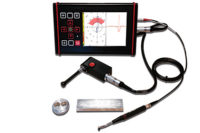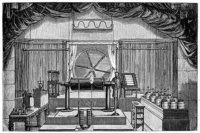The Changing Image of Eddy Current

Eddy current inspection can offer significant, practical advantages over other inspection techniques in certain situations. Unlike ultrasonic inspection, there is no need for any couplant; it can be used on wet surfaces and there is no need for consumables, unlike dye penetrant, wet film radiography and magnetic particle inspection (MPI) techniques. Moreover, as it is a noncontact method, paint coatings and insulation need not be removed during inspection. The technique is suitable for a wide range of applications, and it is universally applied in crack detection. By measuring material conductivity, it is used in quality control in non-ferrous metal sorting and in sorting ferrous metals according to required material properties. It is used to assess coating thickness and tube wall thickness and sub-surface corrosion.
However, displayed results of eddy current inspections often require interpretation by skilled personnel, and the displays themselves are often difficult to read and can mitigate against fast sentencing. Fortunately, significant advances in equipment design and eddy current technology are literally changing the image-and images-of eddy current inspection.

New eddy current instrumentation offers color-coding of channels to enhance signal interpretation. Source: GE Sensing & Inspection Technologies
Easier to Read Displays
New eddy current instrumentation offers color-coding of channels to enhance signal interpretation. Specifically, color-coding can be used to highlight specific data to allow easier, faster and more reliable interpretation of displayed signals, as each inspection channel is assigned its own color. Color-coding also can be used to differentiate between stored and active signals, and it is possible to use color to obtain a more distinct differentiation between the graticule and the signal. With a choice of color combinations, viewability can be optimized for specific situations according to personal taste.Ease of use also has been addressed with the new generation of eddy current instruments. Texts are easy to read and the on-screen menu allows all functions and parameters to be set and stored for future recall in an on-board memory that has the capacity for 200 setups and 200 traces. USB connectivity allows safe and fast downloading to a PC or printer.

Eddy current is suitable for a wide range of applications, including crack detection, assessing coating thickness and sub-surface corrosion. Source: GE Sensing & Inspection Technologies
Easier to Interpret Results
Conventionally, the data resulting from an eddy current examination has been displayed on an impedance or phase plane diagram. However, by applying pulsed eddy current technology it is now possible, particularly when looking for multi-layer corrosion, to produce multi-layer C-scan images in addition to the conventional impedance plane display. This is achieved by joining together consecutive snapshot scans and providing display imagery that the non-expert operator can interpret with greater ease, greatly facilitating defect recognition. Ease of interpretation also is facilitated by allowing the vertical component of the processed data to correspond to a given color palette so that corrosion is immediately recognizable and the percentage material loss at a particular layer is clearly indicated.These powerful diagnostic images can now be realized using an instrument that employs a handheld, X-axis encoded array probe to allow rapid surface inspection and direct imaging of large areas.
Pulsed eddy current technology offers significant advantages over conventional eddy current. Because it uses a drive coil that is excited by a broadband impulse, which is rich in low frequencies, the range of transient eddy currents also is rich in low frequencies. These lower frequencies penetrate more deeply into a test material, therefore taking longer to return. Consequently, when inspecting for multi-layer corrosion, the time-based information can be gated to present a layer-by-layer C-scan array, which is much easier to read and interpret than conventional phase plane displays, although conventional displays can be presented if required.
One area that is exciting interest for the application of pulsed eddy current technology is the aerospace sector. Both military and civil aircraft make extensive use of single aluminum sheets and lap splices, which are riveted connections between several thin (0.7- to 3-millimeter) aluminum layers. These have conventionally been inspected by multiplexing EC excitation frequencies in time or by mixing different frequencies to look at different layers’ depths. Pulsed excitation is the equivalent of superimposing a range of frequencies simultaneously at one point. A new transient response also is collected at every point and the processing time interval is chosen to have indications from all defects in the inspected material. As a result, a clear image can be generated showing the extent of corrosion at the rivet areas throughout the layers.

Pulsed eddy current technology offers significant advantages over conventional eddy current. Source: GE Sensing & Inspection Technologies
Conclusions
The development of eddy current as an inspection technology is on-going. For example, investigations are currently being carried out regarding the application of 2-D sensors, where X-Y coded probes will allow faster, easier coverage and provide instantaneous imaging of areas of interest without mechanical scanning. Work also is being done on extending the size and width of probes for special applications, and ways to increase scanning speeds are being developed. Improvements in crack detection are being progressed as, at the moment, cracks are detected only at given orientations. Faster data recall and reduced storage requirements are promised by developments in pre-processing and data compression, while automatic flaw recognition will further increase ease of data interpretation.However, data display and data interpretation remain important components of any nondestructive examination, be that ultrasonics, radiography, remote visual inspection or eddy current. Without clear display of data and ease of interpretation of displayed information, the danger of missed and false calls increases dramatically. By enhancing the viewing platform of eddy current instrumentation, by simplifying sentencing procedures, by color-coding selected information and by developing new technology to allow information to be presented in more user-friendly ways, eddy current inspection can realize its full potential. NDT
Looking for a reprint of this article?
From high-res PDFs to custom plaques, order your copy today!








